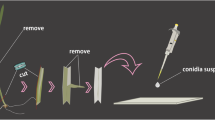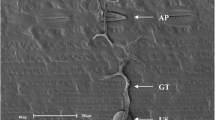Abstract
Fusarium langsethiae is one of the common Fusarium species infecting small grain cereals in the Nordic region and the UK. It is usually described as a weak pathogen, and with a strong preference for oats, although no studies have yet addressed the explanations for this at the microscopic level. Using microscope techniques we have studied the early steps of colonization of oat and wheat grain by F. langsethiae particularly addressing the role of pollen in the infection process and the fungal ability to penetrate plant cell wall. The aim was to better understand its non-aggressive colonization picture and why oat is preferred over wheat as a host. Spray inoculated oat and wheat plants were scored for fungal progression at 3, 6, 10 and 14 days post inoculation (dpi) using light microscopy and scanning electron microscopy (SEM). Fungal hyphae entered the grain at the apex, or along the sides in the overlapping zone between palea wings and lemma, then spread basipetally and laterally, with a clear directional growth towards the caryopsis. Hyphal growth was clearly aided by the presence of pollen. On oat proliferating hyphae developed a variety of penetration structures on all internal surfaces. F. langsethiae infection on wheat progressed along the same routes, however slower and overall with less hyphal mass. Interestingly, hyphae closely associated to the wheat caryopsis seemed to undergo degradation, and profuse conidiation was observed at 14 dpi. Explanations for the differences in F. langsethiae colonization of oat versus wheat are suggested in light of the results.






Similar content being viewed by others
References
Armentrout, V. N., & Downer, A. J. (1987). Infection cushion development by Rhizoctonia solani on cotton. Phytopathology, 77(4), 619–623. https://doi.org/10.1094/Phyto-77-619.
Berthiller, F., Crews, C., Dall'Asta, C., Saeger, S. D., Haesaert, G., Karlovsky, P., Oswald, I. P., Seefelder, W., Speijers, G., & Stroka, J. (2013). Masked mycotoxins: A review. Molecular Nutrition & Food Research, 57(1), 165–186. https://doi.org/10.1002/mnfr.201100764.
Boenisch, M. J., & Schafer, W. (2011). Fusarium graminearum forms mycotoxin producing infection structures on wheat. BMC Plant Biology, 11, 110. https://doi.org/10.1186/1471-2229-11-110.
Buerstmayr, M., & Buerstmayr, H. (2015). Comparative mapping of quantitative trait loci for Fusarium head blight resistance and anther retention in the winter wheat population capo x Arina. Theoretical and Applied Genetics, 128(8), 1519–1530. https://doi.org/10.1007/s00122-015-2527-8.
Deacon, J. (2006). Differentiation and development. In Fungal Biology (4th ed.): Blackwell Publishing.
Divon, H. H., Razzaghian, J., Udnes-Aamot, H., & Klemsdal, S. S. (2012). Fusarium langsethiae (Torp and Nirenberg), investigation of alternative infection routes in oats. European Journal of Plant Pathology, 132(1), 147–161.
Edwards, S. G. (2009). Fusarium mycotoxin content of UK organic and conventional oats. Food Additives and Contaminants Part A - Chemistry Analysis Control Exposure & Risk Assessment, 26(7), 1063–1069.
Edwards, S. G., Imathiu, S. M., Ray, R. V., Back, M., & Hare, M. C. (2012). Molecular studies to identify the Fusarium species responsible for HT-2 and T-2 mycotoxins in UK oats. International Journal of Food Microbiology, 156(2), 168–175. https://doi.org/10.1016/j.ijfoodmicro.2012.03.020.
Escriva, L., Font, G., & Manyes, L. (2015). In vivo toxicity studies of Fusarium mycotoxins in the last decade: A review. Food and Chemical Toxicology, 78, 185–206. https://doi.org/10.1016/j.fct.2015.02.005.
Hjelkrem, A. G. R., Aamot, H. U., Brodal, G., Strand, E. C., Torp, T., Edwards, S. G., Dill-Macky, R., & Hofgaard, I. S. (2018). HT-2 and T-2 toxins in Norwegian oat grains related to weather conditions at different growth stages. European Journal of Plant Pathology, 151(2), 501–514. https://doi.org/10.1007/s10658-017-1394-3.
Hofgaard, I. S., Aamot, H. U., Torp, T., Jestoi, M., Lattanzio, V. M. T., Klemsdal, S. S., Waalwijk, C., van der Lee, T., & Brodal, G. (2016a). Associations between Fusarium species and mycotoxins in oats and spring wheat from farmers' fields in Norway over a six-year period. World Mycotoxin Journal, 9(3), 365–378. https://doi.org/10.3920/Wmj2015.2003.
Hofgaard, I. S., Seehusen, T., Aamot, H. U., Riley, H., Razzaghian, J., Le, V. H., et al. (2016b). Inoculum potential of Fusarium spp. relates to tillage and straw Management in Norwegian Fields of spring oats. Frontiers in Microbiology, 7, 556. https://doi.org/10.3389/fmicb.2016.00556.
Huang, L., Buchenauer, H., Han, Q., Zhang, X., & Kang, Z. (2008). Ultrastructural and cytochemical studies on the infection process of Sclerotinia sclerotiorum in oilseed rape. Journal of Plant Diseases and Protection, 115(1), 9–16.
Imathiu, S. M., Ray, R. V., Back, M., Hare, M. C., & Edwards, S. G. (2009). Fusarium langsethiae pathogenicity and aggressiveness towards oats and wheat in wounded and unwounded in vitro detached leaf assays. European Journal of Plant Pathology, 124(1), 117–126.
Imathiu, S. M., Hare, M. C., Ray, R. V., Back, M., & Edwards, S. G. (2010). Evaluation of pathogenicity and aggressiveness of F. langsethiae on oat and wheat seedlings relative to known seedling blight pathogens. European Journal of Plant Pathology, 126(2), 203–216.
Jansen, C., von Wettstein, D., Schafer, W., Kogel, K. H., Felk, A., & Maier, F. J. (2005). Infection patterns in barley and wheat spikes inoculated with wild-type and trichodiene synthase gene disrupted Fusarium graminearum. Proceedings of the National Academy of Sciences of the United States of America, 102(46), 16892–16897. https://doi.org/10.1073/pnas.0508467102.
Kang, Z., & Buchenauer, H. (2000). Ultrastructural and cytochemical studies on the infection of wheat spikes by Fusarium culmorum as well as on degradation of cell wall components and localization of mycotoxins in the host tissue. Mycotoxin Research, 16(Suppl 1), 1–5. https://doi.org/10.1007/bf02942968.
Kang, Z., Zingen-Sell, I., & Buchenauer, H. (2005). Infection of wheat spikes by Fusarium avenaceum and alterations of cell wall components in the infected tissue. European Journal of Plant Pathology, 111(1), 19–28. https://doi.org/10.1007/s10658-004-1983-9.
Larmour, R., & Marchant, R. (1977). The induction of conidiation in Fusarium culmorum grown in continuous culture. Journal of General Microbiology, 99, 49–58.
Lattanzio, V. M. T., Visconti, A., Haidukowski, M., & Pascale, M. (2012). Identification and characterization of new Fusarium masked mycotoxins, T2 and HT2 glycosyl derivatives, in naturally contaminated wheat and oats by liquid chromatography-high-resolution mass spectrometry. Journal of Mass Spectrometry, 47(4), 466–475. https://doi.org/10.1002/jms.2980.
Lu, Q., Lillemo, M., Skinnes, H., He, X., Shi, J., Ji, F., Dong, Y., & Bjørnstad, Å. (2013). Anther extrusion and plant height are associated with type I resistance to Fusarium head blight in bread wheat line 'Shanghai-3/Catbird'. Theoretical and Applied Genetics, 126(2), 317–334. https://doi.org/10.1007/s00122-012-1981-9.
Martin, C., Schoneberg, T., Vogelgsang, S., Mendes Ferreira, C. S., Morisoli, R., Bertossa, M., et al. (2018). Responses of oat grains to Fusarium poae and F. langsethiae infections and mycotoxin contaminations. Toxins, 10(1). https://doi.org/10.3390/toxins10010047.
Martyniuk, S., Stochmal, A., Macias, F. A., Marin, D., & Oleszek, W. (2006). Effects of some benzoxazinoids on in vitro growth of Cephalosporium gramineum and other fungi pathogenic to cereals and on Cephalosporium stripe of winter wheat. Journal of Agricultural and Food Chemistry, 54(4), 1036–1039. https://doi.org/10.1021/jf050901x.
Matsuura, K. (1986). Scanning electron microscopy of the infection process of Rhizoctonia solani in leaf sheaths of rice plants. Cytology and Histology, 76(8), 811–814.
Medina, A., & Magan, N. (2010). Comparisons of water activity and temperature impacts on growth of Fusarium langsethiae strains from northern Europe on oat-based media. International Journal of Food Microbiology, 142(3), 365–369. https://doi.org/10.1016/j.ijfoodmicro.2010.07.021.
Miller, S. S., Chabot, D. M. P., Ouellet, T., Harris, L. J., & Fedak, G. (2004). Use of a Fusarium graminearum strain transformed with green fluorescent protein to study infection in wheat (Triticum aestivum). Canadian Journal of Plant Pathology-Revue Canadienne de Phytopathologie, 26(4), 453–463.
Nazari, L., Pattori, E., Terzi, V., Morcia, C., & Rossi, V. (2014). Influence of temperature on infection, growth, and mycotoxin production by Fusarium langsethiae and F. sporotrichioides in durum wheat. Food Microbiology, 39, 19–26. https://doi.org/10.1016/j.fm.2013.10.009.
Niemeyer, H. M., Copaja, S. V., & Barria, B. N. (1992). The Triticeae as Sources of Hydroxamic Acids, Secondary Metabolites in Wheat Conferring Resistance against Aphids. Hereditas, 116(3), 295–299. https://doi.org/10.1111/j.1601-5223.1992.tb00158.x.
Opoku, N., Back, M., & Edwards, S. G. (2013). Development of Fusarium langsethiae in commercial cereal production. European Journal of Plant Pathology, 136(1), 159–170. https://doi.org/10.1007/s10658-012-0151-x.
Opoku, N., Back, M. A., & Edwards, S. G. (2018). Susceptibility of cereal species to Fusarium langsethiae under identical field conditions. European Journal of Plant Pathology, 150(4), 869–879. https://doi.org/10.1007/s10658-017-1329-z.
Parikka, P., Hakala, K., & Tiilikkala, K. (2012). Expected shifts in Fusarium species' composition on cereal grain in northern Europe due to climatic change. Food Additives & Contaminants. Part A, Chemistry, Analysis, Control, Exposure & Risk Assessment, 29(10), 1543–1555. https://doi.org/10.1080/19440049.2012.680613.
Schalchli, H., Pardo, F., Hormazabal, E., Palma, R., Guerrero, J., & Bensch, E. (2012). Antifungal activity of wheat root exudate extracts on Gaeumannomyces graminis var. tritici growth. Journal of Soil Science and Plant Nutrition, 12(2), 329–337. https://doi.org/10.4067/S0718-95162012000200012.
Schmidt, H., Adler, A., Holst-Jensen, A., Klemsdal, S. S., Logrieco, A., Mach, R. L., Nirenberg, H. I., Thrane, U., Torp, M., Vogel, R. F., Yli-Mattila, T., & Niessen, L. (2004). An integrated taxonomic study of Fusarium langsethiae, Fusarium poae and Fusarium sporotrichioides based on the use of composite datasets. International Journal of Food Microbiology, 95(3), 341–349.
Skadsen, R. W., & Hohn, T. A. (2004). Use of fusarium graminearum transformed with gfp to follow infection patterns in barley and Arabidopsis. Physiological and Molecular Plant Pathology, 64(1), 45–53. https://doi.org/10.1016/j.pmpp.2004.04.003.
Strange, R. N., & Smith, H. (1978). Specificity of choline and betaine as stimulants of fusarium-Graminearum. Transactions of the British Mycological Society, 70(APR), 187–192.
Tekle, S., Dill-Macky, R., Skinnes, H., Tronsmo, A. M., & Bjornstad, A. (2012). Infection process of fusarium graminearum in oats (Avena sativa L.). European Journal of Plant Pathology, 132(3), 431–442. https://doi.org/10.1007/s10658-011-9888-x.
Thrane, U., Adler, A., Clasen, P. E., Galvano, F., Langseth, W., Logrieco, A., et al. (2004). Diversity in metabolite production by Fusarium langsethiae, Fusarium poae, and Fusarium sporotrichioides. International Journal of Food Microbiology, 95(3), 257–266.
Torp, M., & Adler, A. (2004). The European Sporotrichiella project: A polyphasic approach to the biology of a new Fusarium species. International Journal of Food Microbiology, 95(3), 241–245.
Torp, M., & Nirenberg, H. I. (2004). Fusarium langsethiae sp nov on cereals in Europe. International Journal of Food Microbiology, 95(3), 247–256.
Wanjiru, W. M., Kang, Z. S., & Buchenauer, H. (2002). Importance of cell wall degrading enzymes produced by fusarium graminearum during infection of wheat heads. European Journal of Plant Pathology, 108(8), 803–810.
Wu, H. W., Haig, T., Pratley, J., Lemerle, D., & An, M. (2002). Biochemical basis for wheat seedling allelopathy on the suppression of annual ryegrass (Lolium rigidum). Journal of Agricultural and Food Chemistry, 50(16), 4567–4571. https://doi.org/10.1021/jf025508v.
Xu, X. M., Madden, L. V., & Edwards, S. G. (2014). Modeling the effects of environmental conditions on HT2 and T2 toxin accumulation in field oat grains. Phytopathology, 104(1), 57–66. https://doi.org/10.1094/Phyto-03-13-0070-R.
Acknowledgements
We thank Jafar Razzaghian for technical assistance, and Mona Torp and Trude Vrålstad for helpful discussions and critical reading. Also thanks to the Imaging Centre at NMBU Campus, Ås, for technical assistance with microscopy. This work was funded by the Norwegian Research Council, Foundation for Research Levy on Agricultural Products, Bioforsk (project no. 185007/I10), and the FUNtox strategic program at the Norwegian Veterinary Institute.
Author information
Authors and Affiliations
Corresponding author
Ethics declarations
Conflict of interest
The authors declare that they have no conflict of interest.
Human and animal studies
The conducted research does not involve human participants or animals.
Rights and permissions
About this article
Cite this article
Divon, H.H., Bøe, L., Tveit, M.M.N. et al. Infection pathways and penetration modes of Fusarium langsethiae. Eur J Plant Pathol 154, 259–271 (2019). https://doi.org/10.1007/s10658-018-01653-3
Accepted:
Published:
Issue Date:
DOI: https://doi.org/10.1007/s10658-018-01653-3




